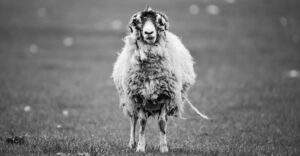It turns out that scientists have deciphered honeybee dances, and that these dances serve as a kind of communication amongst bees about where to obtain food, a new home, and similar matters. The data used in the Schafberg Experiment—so termed because it was conducted on the mountain itself—was gathered using this information. On the opposite side of the mountain was the sole food source for the colony.
Over the Mountain, the Bees Were Unable to Fly
Even though they had never flown to the food source—rather, they would have had to mentally calculate the angle—they communicated this angle perfectly over the mountain, relative to themselves, when they conveyed the location of the food.
Their customary dances for locating food provide more proof of this extraordinary talent and that they account for the round nature of the globe. Honey bees will dance on the surface of a comb to signal the location of a food source. The dance is performed by the bee in a circular motion; with each turn, it will cut the circle at an angle; the angle relative to noon indicates the angle at which the bee should travel about the sun.
So, if the bee’s flight path began at 6 o’clock and ended at noon, it would indicate a forward direction towards the sun, a rightward direction toward the sun from 7 to 1 o’clock, and a direct inverse direction from 12 to 6 o’clock.
The best part is that these small dances can go on for quite a while. Consequently, the sun’s inclination will have altered throughout that time. Even the dances’ communication can take the entire night. The bee determines the change in angle by observing the current position of the sun about the hive while dancing.
In other words, if the dance is taking place at night, they adjust the angles so that they line up with the current position of the sun around the globe! A similar process occurs when bees fly toward food by instructions; they adjust their knowledge according to the current position of the sun relative to when the directions were given. Bees, in a nutshell, are little math nerds with exceptional timekeeping skills and the capacity to determine distances without the use of any visible measuring equipment.
They must now know not only the angles but also the distances required to travel in each direction. They achieve this by wriggling their bellies as they traverse the circle. This is not some nebulous concept of distance; in fact, the more wiggles there are, the greater the distance.
The bees keep fairly accurate track of the distance they need to travel and relay that information to one another. When the distance to the food source is less than 80 meters, bees will simply point you in the right way without wriggling their bodies.
The intriguing things that honey bees do extend beyond this, though. A plethora of more mind-blowing details on the marvelous honey bee were also shown to me today:
- Age has a role in how honey bees divide up their labor. For example, bees in the worker stage typically clean their cells (beginning with the one they were born into) and keep the brood warm. Between three and five days of age, they feed the older larvae. Between six and eleven days of age, they feed the youngest larvae. Between twelve and seventeen days of age, they create wax, make combs, transport food, and carry out undertaker duties. Between eighteen and twenty-one days of age, they take on guard duty, protecting the entrance to the hive. From day 22 onward, they can fly from the hive, collecting pollen, nectar, water, and pollinating plants, among other things.
- While stinging humans does kill honey bees, stinging most other objects does not. The bees’ demise is certain when the barbs of the stinger entangle with our flesh, causing the stinger and part of the bees inside to be severed. Stinging insects, for example, can sting repeatedly without risking injury to themselves because this is not the case for them.
- In a typical flight, a honey bee can reach speeds of up to fifteen to twenty miles per hour.
- Honey bees have colorblindness for red light but excellent UV vision; flowers serve as optical beacons for these bees since they reflect so much UV light.
No indigenous bee species has ever lived in the Americas. - Europeans were the ones who brought them over. Native Americans used the term “white man’s fly” to describe honeybees.
- To produce only one pound of honey, an entire colony of honey bees will travel approximately 55,000 kilometers.
- Also, during a successful season, a hive can produce 60 pounds of honey, which is around 25 pounds more than what is needed for winter survival.
The bees will choose to produce a new queen bee when the colony becomes too congested. This can be accomplished in the following way:
- Bees build a maximum of twenty wax queen cells.
- Fertilized eggs are laid in each queen cell by the present queen.
- The nurse bees will nourish the queen larvae with royal jelly, a rich, creamy substance, and they will lengthen the cell until it is approximately 25 mm long.
- A layer of wax is applied to the first queen cell nine days after laying.
- The older bees will lead a big swarm of bees out of the hive, which is termed the prime swarm. The elderly queen loses weight and gains flight as she undergoes starvation. After the elder bees persuade the senile queen to become a part of the swarm, they set out to find a new location to establish a colony. Surprisingly, this swarm will stop frequently to send out search parties. After the scouts return, they use the data to determine where to go next.
- The first virgin queen emerges from her cell eight days after the first step. Either she takes another little swarm and departs from this hive to build a new one, or she stays and tends to the current one. Alternatively, she finds other possible queens and stings them through their wax cell walls to destroy them.
- The young queen takes to the air to get a feel for her new home.
- The queen will go on multiple mating flights, during which she will mate with drones, which are male bees; after mating, the drones will die.
- After three days of mating, the queen will start to lay approximately 2000 fertilized eggs daily. Female worker bees develop from fertilized eggs. When male drones fertilize eggs, the result is a new species of drone. One queen bee, forty thousand or more female worker bees, and a few hundred male drones make up a typical colony.
- The queen will remain with the colony for a minimum of one year, or until there is a big enough swarm to relocate to a new location, to start a new colony. The queen bee has a lifespan of up to five years, whereas the worker bees only survive around forty days and the drone bees either die during mating or are expelled from the hive in the fall to save food because they don’t function.
In the summer, a typical colony will have more than 35,000 to 40,000 bees, and in the winter, it will be around 5,000 bees.
The honey bee is a cold-blooded animal. A bee in flight, for example, would usually have a core temperature of around 130 F, even though they are cold-blooded. This is because they can produce heat by vibrating their bodies. But a bee can freeze to death if it gets trapped in freezing rain or anything like that. The ideal temperature for a honeybee colony is approximately 98 degrees Fahrenheit.
How Do Bees Make Honey?
To create honey, honeybees combine floral nectar with digestive enzymes produced by glands in their mouths. The next step is to let the water content drop to about 17% before storing it in hexagonal wax honeycombs. After this, the bees will put a wax seal on the combs and keep them there until they need them for nourishment, such as in the winter.
The earliest known honey that is still good was discovered in the tombs of Pharaohs, which were sealed more than three thousand years ago, and it is still delicious. Capped honey can be preserved for thousands of years without rotting.
Honey bees produce wax by heating a swarm of bees in a tight cluster. Slowly, slivers of wax are secreted by the glands under their abdomen that produce wax. These wax strands are collected by other worker bees, who subsequently transport them to their respective locations.
Every pound of wax that honey bees generate, requires around six pounds of honey consume. The creamy white, protein-and fatty acid-rich Royal Jelly is reserved for the queen and her offspring. The mouth glands of beehives create this chemical. Despite the numerous purported health benefits, it is prohibitively expensive to purchase due to the small amount required (just enough for one bee).
You won’t see honey bees hibernating. Although they are cold-blooded, these bees remain rather active all year round, spending much of their time indoors in the hive during winter. Even among bee species, honeybees have the most complex behaviors and the most advanced colonies, leading many to believe that they represent the pinnacle of insect existence.
When beehives get new queens, the bees’ demeanor and actions will shift. Because of this feature, beekeepers can regulate aggressiveness and labor enthusiasm among bee colonies.
In the event of the queen bee’s untimely demise, the worker bees will promptly begin the process of reproducing from the queen’s existing larvae. A queen bee can be transformed from a larva as long as the larvae are less than three days old. When a queen bee dies, her pheromones will no longer be detected by the bees.
Honey bees communicate with each other through highly complex pheromones.
Although there is constant activity in the hive all year round, honey bees do sleep, contrary to popular assumption. It was observed in 1988 that honey bees can experience periods of relaxation, low body temperature, and relative in responsiveness when they take a break. Even though their sleep is very different from human sleep, it is nonetheless categorized as sleep.
No Surprise Beekeepers Have to Be So Efficient
It takes two million blossoms to produce only one pound of honey. Because they may have to leave the hive if a fire breaks out, bees respond to smoke by stopping what they’re doing and eating as much honey as they can. While tending to the hive, beekeepers might avoid becoming overwhelmed by the swarm by focusing on something else. Around 13,000 years ago, people began keeping beehives and extracting honey. The Egyptians were particularly adept at this practice.
Honey has many beneficial therapeutic properties and is one of the healthiest foods you can eat ounce for ounce. Additionally, it is an effective antimicrobial and helps with the removal of pink eye, the healing of burns, and the alleviation of pain from severe burns. Eating honey produced in your neighborhood might also help alleviate allergies.
Even after working for 16 hours a day for half of its life, or 20 days, a worker bee will only produce 1/12 of a teaspoon of honey.
Their labor division based on age, intricate hive dynamics, and the meticulous process of queen production highlights their adaptability and resilience.
The complex ways in which they produce honey, their hive maintenance, and even their response to smoke during emergencies allude to a species finely tuned to the world around them, emphasizing their incredible role in nature’s delicate balance.

The common belief that chameleons change their colors to match their environment is a bit…

Contrary to popular belief, the majestic creatures roaming North America are not American buffalo but…

Rabbits and hares are often mistakenly used interchangeably, but they are distinct creatures with significant…

In the vast and mysterious world of marine animals, there lies a common misconception that…

The majority of people, when hearing the word “extinct” about animals, will immediately think of…

